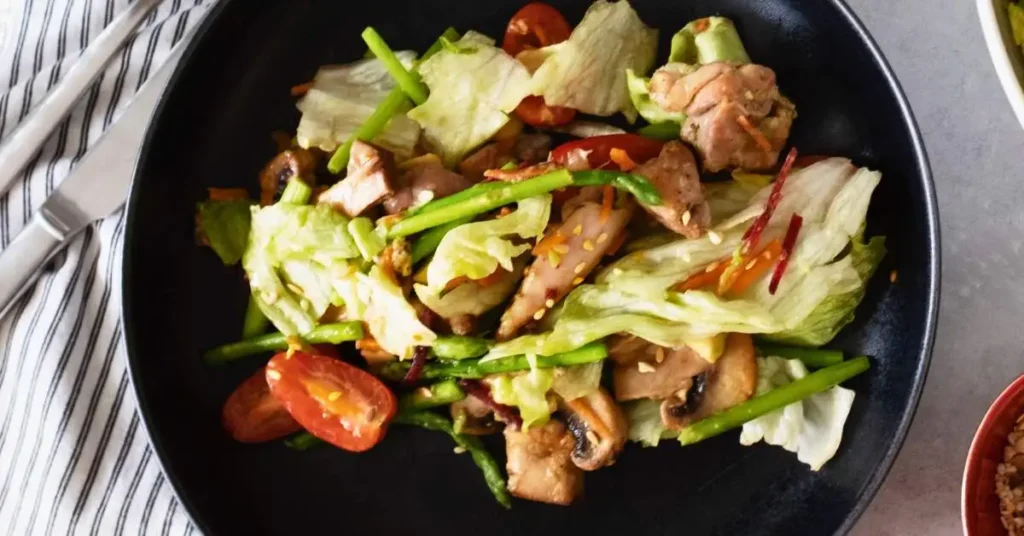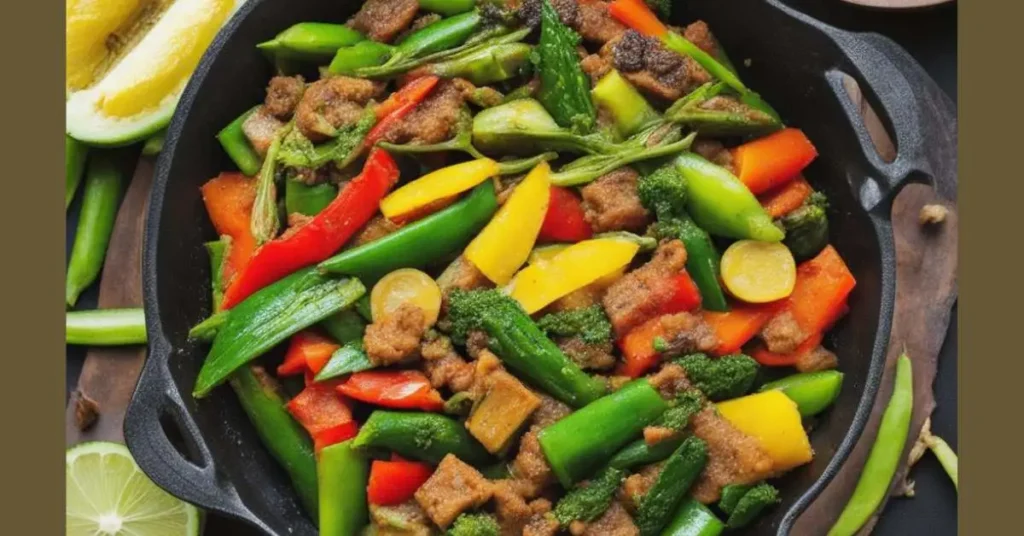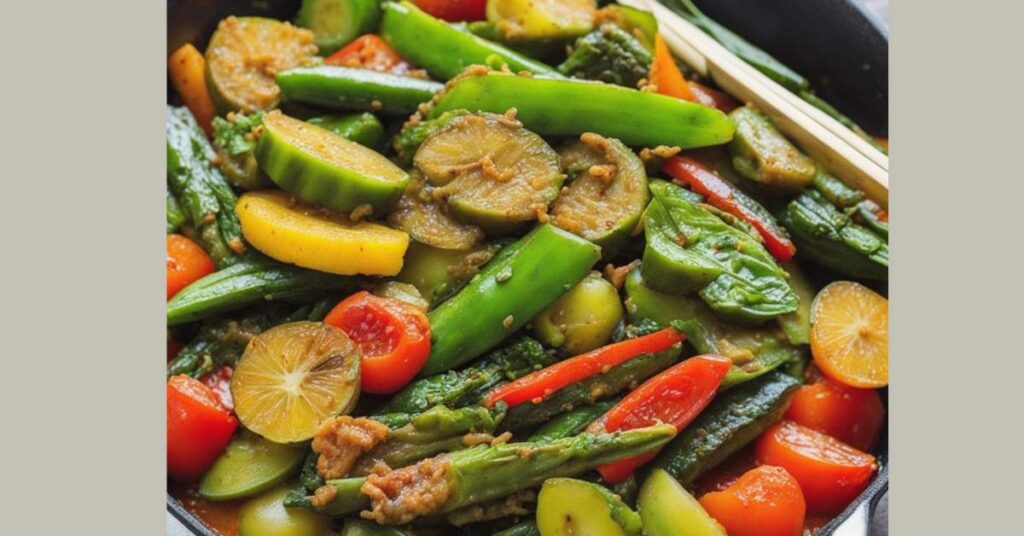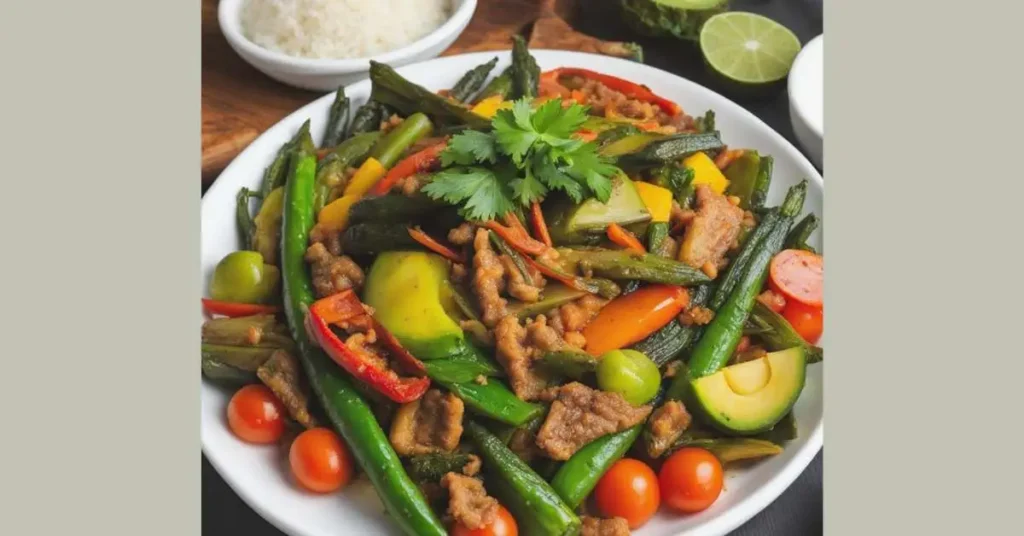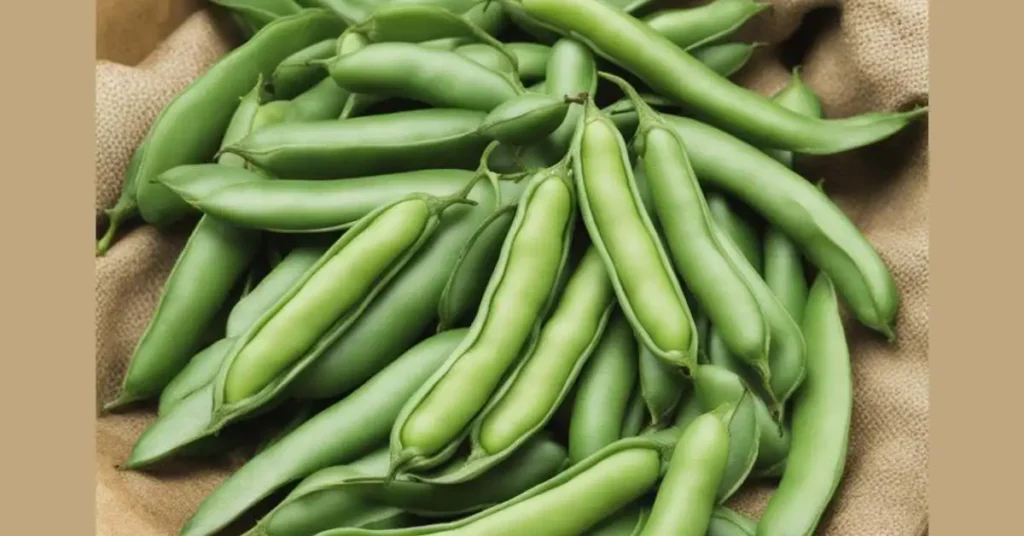Get ready for a taste of the tropics with our Hawaiian pinakbet recipe!
🍍🌿 Packed with fresh veggies and bold flavors, it’s a delightful dish for any meal.
Try it today! #HawaiianPinakbet #TropicalFlavors #EasyRecipes
So grab a seat and get ready to go on a taste-bud-teasing gastronomic trip that will take you to the warm shores of Hawaii!
Table of Content
- 1 How did I learn this dish?
- 2 Recipe
- 3 Method Instructions
- 4 Recipe Video
- 5 What to Pair with Hawaiian Pinakbet Recipe?
- 6 Servings
- 7 Tips
- 8 Ingredient Substitutes
- 9 FAQ’S Pinakbet Recipe Hawaii:
- 9.1 What is the difference between pakbet and pinakbet?
- 9.2 Can I eat pinakbet everyday?
- 9.3 Why is pinakbet special?
- 9.4 Where did pinakbet originated?
- 9.5 What is the English of pinakbet?
- 9.6 What is best paired with pinakbet?
- 9.7 Why do Filipinos love pinakbet?
- 9.8 What to eat with pinakbet?
- 9.9 What is bagoong made of?
- 9.10 What is similar to pinakbet?
- 9.11 What are the other names of pinakbet?
- 9.12 What is pinakbet rich in?
- 10 Remarks
How did I learn this dish?
You know, that cooking is about enjoying an adventure of memories, not just following recipes.
Now allow me to share with you a little about how I came up with this delicious pinakbet recipe panlasang pinoy. It all started when I was a little child, watching my grandmother do cooking magic.
She was a strong chef who expertly combined tastes and spices to produce meals that had a homey taste.
It was love at first taste when I tasted her pinakbet, a recipe she had learned from her own grandmother, as I recall.
I will never forget the taste of tradition—the heady scent of sautéed veggies, the savory undertones of shrimp paste, and the filling satisfaction of every bite.
Let’s now discuss the recipe’s history and its relationship to Hawaii’s colorful culture:
- Mixture of cultures: Pinakbet came from the Philippines, but Filipino immigrants carried their cooking customs with them, and as a result, pinakbet made its way to Hawaii.
- Island Influence: Pinakbet was given a unique makeover in Hawaii by combining regional ingredients such as bitter melon, eggplant, and Hawaiian chili peppers, giving this traditional meal a dash of island flair.
- Culinary Heritage: Pinakbet is still a popular dish in Hawaii today, signifying the islands’ rich cooking diversity and culture.
Thus, as we enjoy the flavors of this well-loved dish, let’s remember the generations of cooks who kept their kitchen customs and passed down their recipes along with enjoying the taste.
Recipe
With each bite of our delicious pinakbet recipe, which is a beautiful medley of fresh veggies and seafood paste, you will be taken to the sunny coasts of the Philippines and introduced to the lively flavors of Filipino cuisine.
Ingredients
Category: Main Dish, Vegetable Dish
Cuisine: Filipino, Hawaiian
Prep Time: 15-20 minutes
Cook Time: 20-25 minutes
servings: 6
Calories: 150-200 calories per serving
| 2 tablespoons vegetable oil |
| 4 cloves garlic, minced |
| 1 onion, sliced |
| 2 tomatoes, sliced |
| 1 small bitter melon (ampalaya), sliced |
| 1 small eggplant, sliced |
| 1 cup (150g) sliced okra |
| 1 cup (150g) sliced squash (calabaza) |
| 1 cup (150g) sliced long beans (sitaw) or green beans |
| 1 cup (150g) sliced pumpkin |
| 1 cup (150g) sliced yardlong beans (optional) |
| 1 cup (150g) sliced sweet potato (optional) |
| 1 cup (240ml) water or vegetable broth |
| 2 tablespoons fish sauce |
| Salt and black pepper to taste |
Method Instructions
As a chef, I believe that cooking is not just about following instructions; it’s about infusing every step with love and care. Let’s get started on making our delicious Pinakbet dish by rolling up our arms.
- Let us start by giving our hands a good, thorough wash. Don’t you think that a wonderful dinner starts with clean hands?
- In a large pan, warm up some vegetable oil over medium heat. When it’s heated, add the minced garlic and sauté it for one to two minutes, till it’s fragrant.
- Add the tomatoes and onions after that, and stir every now and again till the ingredients start to soften and release their juices. This ought to require three to four minutes.
- It’s time to add our vibrant array of vegetables—the star of the show! Arrange the sliced sweet potatoes or yardlong beans among the alternative vegetables, along with the bitter melon, eggplant, okra, squash, and long beans. Give them time to have fun and get to know one another in person.
- In order to steam the vegetables and make a tasty sauce, pour in the water or vegetable broth. To make sure the vegetables are coated equally, give everything a little movement.
- This is when the flavor explosion happens: add the fish sauce (or halal-friendly substitute) and season to taste with a bit of salt and black pepper. After giving everything a good stir, give the flavors a few more minutes to grow.
- When the vegetables are soft but still have bright colors, cover the pan and boil the pinakbet on low heat for around 15 to 20 minutes.
- Taste everything one last time, and adjust the seasoning if needed once it’s all cooked to perfection. You are welcome to add additional salt or pepper to taste.
- And there you have it, my friends—a delicious pot of pinakbet, all ready to be enjoyed with your favorite side dish or over steaming rice.
- All that is left to do is savor the produce—or rather, the fruits—of your effort! You will not mistake trying this Pinakbet recipe for dinner.
You are able to make everyone ask for seconds by adding a generous amount of taste and a small amount of love. Have fun in the kitchen!
Recipe Video
Pinakbet Recipe Hawaii
This is the video about how to make Pinakbet Recipe Hawaii at home.
Author: Hawaii’s Pickle Lady
Rated: 4.3 of 5.0 from 134 reviews.
You May Also Like
What to Pair with Hawaiian Pinakbet Recipe?
I love experimenting with flavors, and the Hawaiian Pinakbet Recipe is a fantastic way to do just that. It’s a delicious twist on the traditional Filipino dish, adding a tropical flair that makes it unique.
If you want to explore more Puerto Rican flavors, check out the Carne Mechada Puerto Rico.
This hearty, slow-cooked beef is rich and full of flavor, perfect alongside your Hawaiian Pinakbet.
Another great option is the Puerto Rican Shrimp Mofongo.
Servings
Now let’s get look at some fun ways to present our delicious pinakbet dish:
- Rice Bowl Bliss: For a substantial dinner that works well any day of the week, serve our tasty pinakbet over a bed of steaming rice.
- Roll it Up: For a delicious lunch on the run, wrap our pinakbet between warm tortillas.
- Stuffed Squash Surprise: For an attractive dish, hollow up tiny squash and stuff them with our savory pinakbet mixture.
- Vegetable Medley Madness: For a healthy twist, load bell peppers or tomatoes with our pinakbet filling for a colorful and nourishing meal.
- Pasta Perfection: For a tasty pasta dish, combine our pinakbet with cooked pasta and an addition of olive oil.
- Savory Stir-Fry: For a vegetarian-friendly version of this tasty dish, stir-fry our pinakbet using tempeh or tofu.
- Soup Sensation: For a thick soup that’s ideal for chilly days, combine our pinakbet with a pot of vegetable broth.
- Salad Showcase: Toss a bowl of mixed greens with our pinakbet for a delicious, hydrating salad that’s full of nutrients.
- Omelette Extravaganza: For substantial breakfast or brunch alternatives, try our pinakbet as a filling for fluffy omelettes.
- Grilled Veggie Delight: Add some flavor to any picnic or barbecue by grilling our pinakbet veggies on skewers.
The options are unlimited when using these inventive serving ideas.
Tips
Absolutely! Let’s look at ten helpful ideas for making our delicious pinakbet recipe with halal ingredients:
- Oil Control: Sauté your components in just the right amount of oil; too much oil might turn the dish into a greasy mess.
- Soy Sauce Savvy: Since soy sauce varies in salinity, adjust the amount to suit your taste.
- Bitter Melon Balance: Soak bitter melon in salted water for approximately half an hour before cooking to lessen its bitterness.
- Eggplant Excellence: For the finest flavor in your pinakbet, choose firm, young eggplants.
- Okra Optimization: Cook the okra without overcooking it, and toss it carefully to keep it from getting slimy.
- Squash Selection: For the most delicious pinakbet, choose squash cultivars with a bright color and a firm texture.
- Bean Basics: Trim any tough or stringy pieces from the ends of green beans or snap peas before cooking.
- Pumpkin Preparation: To make cooking and serving easier, peel and seed the pumpkin before slicing.
- Yardlong Bean Maintenance: Before slicing, cut the ends of the beans and remove any rough fibers.
- Sweet Potato Strategy: Dice sweet potatoes into uniform pieces for a presentation that is both attractive and evenly cooked.
You’ll be well on your way to becoming an expert at making our delicious pinakbet dish. Prepare to wow your loved ones with your cooking prowess!
Ingredient Substitutes
Hey there, fellow foodies! Let’s look at some creative ingredient swaps that will maintain the taste and halal appeal of your pinakbet dish:
- Oil Options: To add a touch of tropical flavor and a healthy twist, replace vegetable oil with either olive or coconut oil.
- Swap Soy Sauce: For that delicious umami taste without losing flavor, swap out fish sauce for tamari sauce or soy sauce that is suitable for halal cuisine.
- Ampalaya Substitutes: If bitter melon (ampalaya) is difficult to find, consider using cucumber or zucchini instead for a milder flavor and similar texture.
- Eggplant Exchange: If the standard type isn’t available, use other eggplant varieties like globe or Japanese eggplant.
- Options for Okra: To add crunch and color to your pinakbet, try substituting snap peas or green beans for the okra.
- Calabaza Options: For a slightly sweeter and nuttier flavor profile, try substituting butternut or acorn squash for calabaza.
- Bean Bonanza: For a rich in nutrients substitute for long beans (sitaw), use any kind of green beans or snap beans.
- Pumpkin Options: For a substantial complement to your meal, consider substituting sweet potatoes or carrots if pumpkin isn’t in season.
- Swap out yardlong beans with snap peas or green beans for something that has a similar flavor.
- Sweet Potato Substitution: For a delicious take on this classic dish, replace sweet potatoes with normal potatoes or carrots.
You may modify our pinakbet recipe to fit your pantry needs and taste preferences while still making it halal and utterly delicious with these inventive ingredient substitutions. Have fun in the kitchen!
FAQ’S Pinakbet Recipe Hawaii:
What is the difference between pakbet and pinakbet?
Unlike pinakbet, pakbet usually has fewer ingredients and removes shrimp paste.
Can I eat pinakbet everyday?
While pinakbet is a nutritious food, consuming it daily could not result in a well-balanced diet. It’s all about variety!
Why is pinakbet special?
Because of its distinct flavor combination and importance in Filipino cuisine, pinakbet is unique.
Where did pinakbet originated?
The Philippines is where pinakbet first appeared, especially in the Ilocos region.
What is the English of pinakbet?
The English word for the Filipino meal of sautéed vegetables with shrimp paste is pinakbet.
What is best paired with pinakbet?
For a filling supper, pinakbet goes nicely with grilled meat or steaming rice.
Why do Filipinos love pinakbet?
Pinakbet’s delicious flavor, rich cultural history, and wholesome ingredients are why Filipinos adore it.
What to eat with pinakbet?
Pinakbet is typically consumed with grilled meat or fish or with steaming rice.
What is bagoong made of?
Bagoong, a popular condiment in Pinakbet, is created from cooked fish.
What is similar to pinakbet?
Pinakbet and ratatouille are similar in that they are both vegetable dishes cooked in a tasty sauce.
What are the other names of pinakbet?
Other names for pinakbet are pakbet and pinakbet tagalog.
What is pinakbet rich in?
Pinakbet’s abundance of veggies and shrimp paste makes it high in vitamins, minerals, and fiber.
Remarks
Enjoy our wonderful pinakbet recipe, which highlights the joy of sharing delicious meals with loved ones and the beauty of simplicity. Dive into the rich tapestry of Filipino flavors and cultural history. Cheers to good food and cooking!
